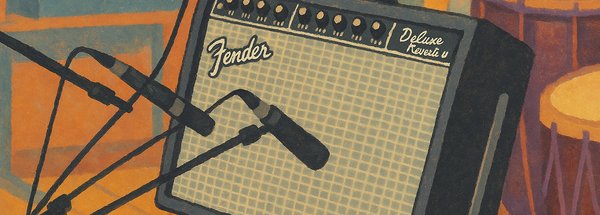
By Teddy Allmendinger
Posted 05/03/2025
Let’s take a look at how to mic up a guitar amplifier. When you think about micing a guitar amp, usually a pretty typical combo amp comes to mind. In my mind, the first thing that comes to my head is a Fender Deluxe Reverb.
Don’t get me wrong, the Fender Deluxe Reverb is a great amp, but in many cases in the studio it’s seen as a “safe choice”. That said, in one of my sessions assistant engineering for Gavin MacKillop (if you’ve seen the show “Friends”, you’ve heard his work) I learned how a simple deviation from the norm can bring brilliant results. I see sessions come in and out every single day and almost always the electric guitars are mic’d the same – with either one SM57 or an SM57 in combination with a Sennheiser 421 on a Deluxe Reverb. Now and again you’ll see the experimental tube mic or the occasional ribbon, but often it’s just those two mics. Now let me be clear, there is absolutely nothing wrong with this. The 57 and the 421 are tried and true and a good player through a half decent amp going into a half decent mic is going to yield a usable strong recording. But if you are looking to expand your mind into the field of fine tuning and tailoring sounds to their specific use cases, then switching up microphones can be an enlightening turn, especially in a place where the “go to” is so satisfying.
Story Time
It was in the heat of the summer during one of my sessions with Gavin. We had 3 whole days booked out at the studio and guitars were on the docket for much of that time. This meant there were several amps with several different mic’s ready to be recorded. I’m going to take you through my observations from that day. I’ll discuss which mic’s we used and why I think they were uniquely resourceful in their own ways.
We were recording a wide range of guitar tones that day, which included anything in between bright and clean to distorted and heavy. On the amp side we had a 70’s Deluxe Reverb, an 80’s Supro and a 90’s Roland JC 120. All of these amps have the capacity to create a bright clean tone and then also be pushed into distortion.
Beyerdynamic M69 + Fender Deluxe Reverb
Let’s go into my first and foremost FAVORITE combination. The Deluxe Reverb paired with a Beyerdynamic M69 N. The Beyer mic is outstanding. It pushes the top end into a bright sparkle while keeping the mids rich and warm. It doesn’t have an excessive production of low end either, making it an easy mix mic. I’ve done back to back shootouts with this mic up against a 421/57 combo, and in every single use case the Beyer M69 wins. This mic can go anywhere from 200-700 bucks. If you see one on the low end of the price range, I highly recommend grabbing it. I bet you won’t throw your 57 near your amp for at least a year.
AKG 414 + Supro
Next up is the Supro paired with an AKG 414. The 414 (Vintage) is a do-everything microphone. I have yet to put that in front of a sound source and feel disappointed with the result. I’ve really noticed how it absorbs the bottom end and tames those frequencies. The Supro is a bright big amp, but can also get really heavy in the low harmonics. The 414 takes that low end and wrestles it into a satisfying spot while preserving the warm juicy mids. An issue I often run into with the high end of a Supro is that it starts to bite. This can become an annoyance that often requires EQ to mitigate. I’ve noticed that the AKG 414 rolls off the bite just a tad and the piercing quality is subdued a good bit.
Beyerdynamic M88 + Roland JC 120
The last combination we had was the JC 120 paired with a Beyerdynamic M88. The M88 has similar characteristics to its relative the M69. The M88 offers a slightly newer sound with a bit more brightness in the high end. I think the M88 might be slightly better for a little bit more volume. It can be pushed slightly harder than the M69 from my experience.
Final Thoughts
Whatever you have access to is the right answer most of the time. These are all just options for you to think about when you’re in a store or the next time you’re on YouTube and want to see what kind of possibilities are there when you’re mic’ing amps. No matter what kind of amp or mic you have, nothing beats a quality performance on a good song.
Cheers,
Teddy
